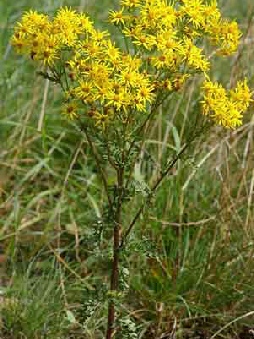
Weeds Download the Leaflet leaflet
Invading

Tel: 01257 450510

These roots or even 1 cm fragments of them may produce adventitious shoots that quickly colonize adjacent spaces. Damage to the parent plant stimulates this process.
Seeds buried deeper than 4 cm in soil can remain dormant for over 16 years. Extremely high seed densities have been reported to accumulate in the soil. Seeds in the upper layer of soil die within 4-6 years and seeds in cultivated soil persist for less than 4 years.
The Ragwort Control Act 2003 has led to the provision of a code of practice, published by DEFRA, that gives guidance on preventing the spread of ragwort.
Common Ragwort (Senecio Jacobaea) contains pyrrolizidine alkaloids which are poisonous to horses, other farm animals and also to wild animals such as hare and deer. It is very important for horse owners and horse pasture owners to recognise and control this potentially fatal plant.
Common Ragwort
A well-established ragwort plant growing in pasture has a spreading rootstock that may be branched and often has a group of offsets derived from the parent. The original taproot rarely persists and it is the secondary system of coarse whitish roots springing from the rootstock and lower stem nodes that acts as a source of new growth.
Roots on a first year crown are able to regenerate from September in year one then as the following September approaches the ability is gradually lost and these roots eventually die. The cycle is then repeated with the new crowns. Severed but undisturbed roots are more likely to regenerate than disturbed ones.


